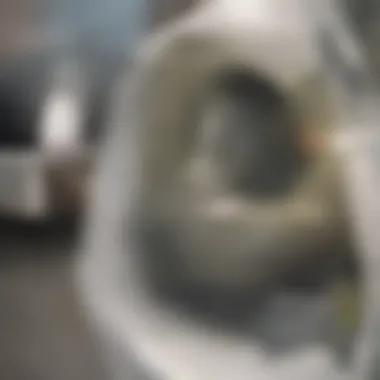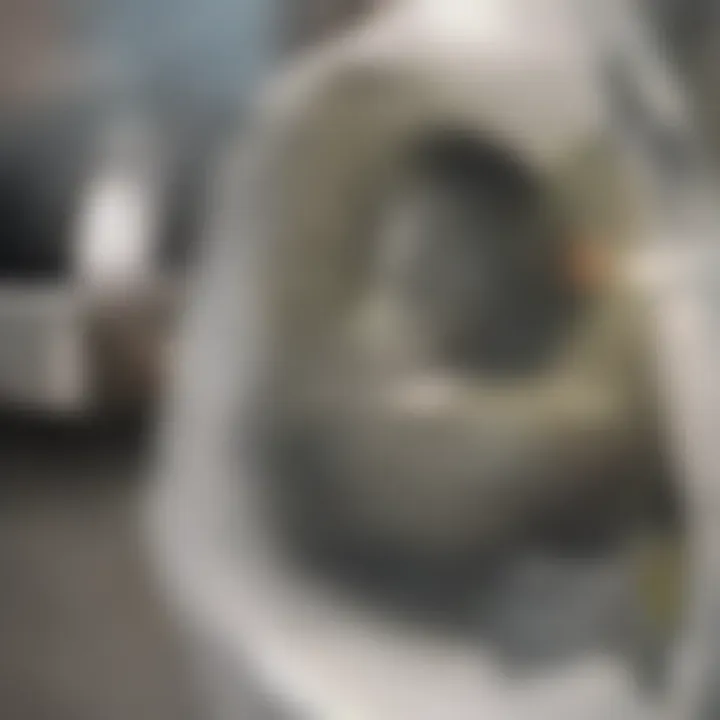Effective Methods to Unclog Your Toilet


Intro
A clogged toilet is a common yet frustrating household challenge that many homeowners face. Understanding the issue along with effective methods to tackle it is invaluable. This guide will illuminate the common causes of toilet clogs, necessary tools, and practical steps to resolve these issues without requiring external help. You will also learn preventive strategies to avoid future clogs.
Common Causes of Toilet Clogs
Toilets can become clogged for various reasons, each requiring its own approach for resolution. Some frequent culprits include:
- Excessive toilet paper usage
- Flushing non-flushable items such as feminine hygiene products or wipes
- Buildup of waste material over time
Recognizing these causes helps in preventing future clogs.
Essential Tools for Addressing Clogs
Before initiating the unclogging process, gather the necessary tools. Common items include:
- A good-quality plunger, preferably a flange plunger
- Rubber gloves for hygiene
- A bucket, in case of overflow
- Plumbing snake for stubborn clogs
Step-by-Step Process to Unclog a Toilet
Following a clear process is essential for success. Here is an effective step-by-step method:
- Preparation: Wear rubber gloves and ensure you have your tools handy.
- Assess the Situation: Check if the toilet bowl is overfull. If so, remove excess water using a bucket.
- Position the Plunger: Place the flange of the plunger in the toilet bowl and create a tight seal.
- Plunge Efficiently: Use firm, quick up and down motions for about 20-30 seconds. Maintain the seal throughout.
- Check for Success: If the water drains, the clog is resolved. If not, repeat the process.
- Consider the Snake: For persistent clogs, use the plumbing snake. Insert it into the toilet and turn the handle to break apart the blockage.
"An effective approach can save both time and money. Having the right tools is essential."
Preventive Measures for Future Clogs
To avoid the reoccurrence of clogs, consider these preventive measures:
- Limit toilet paper use to necessary amounts.
- Educate all household members on what can and cannot be flushed.
- Conduct regular checks for potential buildup or drainage issues.
When Professional Help is Necessary
In some cases, despite trying all methods, the clog may persist. Here are situations when it may be time to call a professional:
- If multiple toilets are clogged.
- Persistent blockage that does not clear after multiple attempts.
- Signs of sewage backup in your home.
By understanding the methods and tools required, you can manage a clogged toilet effectively. Equipped with this knowledge, you will confront and resolve this common household issue like a pro.
Prelude
Dealing with a clogged toilet can be an overwhelming experience, impacting not just comfort but also daily routines. This article aims to provide a thorough understanding of how to tackle toilet clogs efficiently. It consolidates various methods and techniques, empowering homeowners with the knowledge needed for effective resolution.
The significance of addressing clogged toilets cannot be overstated. These incidents are not merely inconveniences; they can lead to health risks, property damage, and disruptions in daily life. Learning effective methods for unclogging a toilet is essential for maintaining a functioning household.
In addition to exploring common causes of clogs, this guide details the tools required for successful unclogging. Step-by-step processes will be meticulously explained, ensuring clarity and usability for readers. Beyond immediate fixes, preventive measures will also be discussed to minimize the chances of future clogs.
By the end of this article, you will not only understand how to resolve a current clog but also be equipped with preventive strategies to maintain your plumbing system. This holistic approach ensures that you are well-prepared to manage one of the most prevalent challenges in household maintenance.
Understanding Toilet Clogs
Addressing the issue of a clogged toilet requires a thorough understanding of what causes these disruptions and their subsequent effects. This section delves into the fundamental aspects of toilet clogs, elucidating the common causes as well as the potential impacts on health, property, and daily routines. Knowledge of these areas helps individuals to take appropriate measures to prevent and remedy clogs, ultimately ensuring the smooth functioning of plumbing systems.
Common Causes of Clogs
Excessive toilet paper use
Excessive toilet paper use is one of the primary contributors to toilet clogs. When too much toilet paper is flushed at once, it can create a blockage in the pipes. The key characteristic here is the volume and density of the paper. This choice is often convenient and regarded as soft and absorbent by many users, but it leads to significant complications in plumbing. Since toilet paper is designed to disintegrate, its effectiveness diminishes when used in large amounts. This uniqueness highlights its tendency to clump and create thick mass that easily hampers the flow of waste. Thus, moderation in use is essential to prevent the undesirable consequences of clogs.
Non-flushable items
Non-flushable items represent another major cause of toilet clogs. Items such as wipes, sanitary products, and dental floss are notorious for creating blockages. Their key characteristic lies in their inability to disintegrate in water, unlike regular toilet paper. While they may seem convenient for quick disposal, these items are not suited for toilets. Their unique feature is that they do not break down, which makes them a significant risk. Their use leads to severe plumbing issues that can require professional intervention, highlighting the need for proper disposal methods.
Foreign objects
Foreign objects, such as toys or personal items, accidentally dropped into the toilet can cause severe blockages. The key characteristic of foreign objects is their size and material. Unlike waste, these items cannot disintegrate. This choice is often unintentional, but its consequences can be dire. The unique feature of foreign objects is their solid nature, which can create a significant obstruction in the plumbing system. Their introduction into the toilet system often results in immediate blockages, requiring urgent removal and potentially costly repairs, solidifying the need for vigilance and caution in the bathroom.
Impacts of Clogged Toilets
Health hazards
Clogged toilets can pose serious health hazards. When toilets are not functioning properly, there is a risk of waste overflow, potentially exposing individuals to harmful bacteria and pathogens. This situation is particularly concerning in households with children or elderly members. The key characteristic of these health hazards is the potential for disease transmission. Clogged toilets create a breeding ground for germs, which can lead to infections and illness among residents. The unique feature of this impact emphasizes the urgency of addressing clogs promptly.


Property damage
The potential for property damage due to a clogged toilet cannot be overlooked. Overflows can lead to water damage on floors, walls, and even ceilings. The escalation of the situation can result in costly repairs, as key characteristics include the viral spread of water saturating areas of your home. This presents an immediate financial concern and disruption in the living space. Many homeowners are unaware of the unique feature of water damage potentially weakening structural integrity, emphasizing the need for proactive measures to maintain plumbing.
Disruption of daily life
Clogged toilets bring significant disruption to daily life. Such clogs can make a bathroom unusable, which can be quite inconvenient for families and guests. The key characteristic of this disruption often manifests in scheduling conflicts and added stress. More importantly, the unique feature here is how this issue extends beyond mere inconvenience; it can affect work from home arrangements and personal routines. Recognizing this aspect can motivate individuals to take preventative measures against clogs and ensure their bathrooms maintain normal functionality.
Tools for Plunging a Toilet
When facing a clogged toilet, having the right tools is essential to effectively resolve the issue. The tools you select can significantly influence the outcome of your efforts. Understanding the various types of plungers and additional supplies will help you streamline the process, ensuring it is less frustrating and more efficient. Each tool serves a distinct purpose, so it is imperative to choose wisely based on the situation at hand.
Types of Plungers
Cup plunger
The cup plunger is the most common type used by homeowners. It features a rounded rubber cup with a wooden or plastic handle. Its main function is to create a seal over the toilet drain, allowing for pressure to build when force is applied. The key characteristic of the cup plunger is its simplicity and effectiveness in clearing minor clogs. This type is generally a beneficial choice for day-to-day toilet maintenance.
However, it does have limitations. Its effectiveness can diminish when faced with more severe blockages, such as those created by foreign objects or buildup deeper in the plumbing system.
Flange plunger
The flange plunger, also known as a toilet auger, is designed specifically for toilets. It has an extended rubber flap that can fit into the toilet’s drain. This unique feature allows it to create a better seal compared to the cup plunger. The flange plunger is often a preferred choice when tackling more stubborn clogs. Its ability to insert further into the toilet's drain line makes it particularly effective.
One disadvantage is that if not used correctly, the flange can be less effective in other plumbing applications, making it less versatile.
Accordion plunger
The accordion plunger is an alternative option with a more complex design. This type is characterized by its accordion-like shape, which allows for increased suction power. It is especially useful for tougher clogs. It can push more air with less effort, making it efficient in breaking up solid waste. The accordion design is versatile and can be used in multiple plumbing situations.
However, due to its size, it might be harder to maneuver in tight spaces. Additionally, it is not as commonly used, which can limit availability in some households.
Additional Tools and Supplies
Rubber gloves
Rubber gloves are an essential safety item when plunging a toilet. Using gloves protects your hands from exposure to bacteria and waste material. The key characteristic of rubber gloves is their waterproof nature, which allows you to handle messy situations with confidence. They are a beneficial choice for any plumbing job, as hygiene is critical in such scenarios.
One downside is that not all gloves are created equal. Low-quality gloves can tear easily and compromise safety. Thus, it is essential to invest in durable options.
Drain augers
Drain augers, or snakes, are another key tool for stubborn clogs that plungers may not resolve. This tool consists of a long flexible steel cable with a coiled end, which can navigate through pipes to break up or retrieve clogs. The main benefit of drain augers is their ability to reach deep blockages that are otherwise inaccessible. They are particularly effective in dealing with clogs caused by debris accumulated further along the plumbing line.
However, using an auger can sometimes require a learning curve and proper technique to avoid damaging pipes.
Bucket
A bucket serves multiple purposes during the unclogging process. It can be used to collect excess water from the toilet bowl before plunging, preventing spills on the floor. This makes it a practical tool to protect your bathroom environment. Its key characteristic lies in its versatility; you can use it to catch water or as a container for cleaning supplies.
One downside of a bucket is that, if not handled carefully, it can lead to more mess. It is vital to ensure that water doesn’t splash out while using it.
Preparation Steps Before Plunging
Before confronting the challenge of a clogged toilet, it is essential to follow preparation steps. Proper preparation ensures an efficient resolution while minimizing the risk of health hazards and potential damage to the bathroom. Engaging in these steps will not only help in understanding the nature of the blockage but also establish a safe environment for handling the task ahead.
Assessing the Situation
Checking water level
Evaluating the water level in the toilet bowl is crucial as it indicates both the severity of the clog and how to approach the situation. A high water level may signal a severe blockage, while a lower level might suggest a partially cleared drain. Knowing this characteristic allows for informed decision-making on whether additional actions are required.
One unique aspect of checking the water level is determining if it is too high to use a plunger directly without spilling. If it appears excessively full, consider either removing water with a bucket or using a cup to lower the level. This precaution helps avoid messy clean-ups and addresses safety issues while plunging. However, caution should be exercised to prevent overflow, which can lead to further complications.
Identifying obstruction
Identifying the obstruction involves looking for items stuck in the toilet drain. This step is important to determine if a typical plunger can resolve the problem or if alternative methods should be enlisted. Observing any visible items helps prioritize actions and can save time when addressing the issue.
A significant characteristic of identifying obstructions is understanding their source. This knowledge provides context about how best to dislodge it. A foreign object like a child's toy will require different handling than a buildup of toilet paper. Its unique feature is that it informs strategy. For example, if non-flushable materials are found, higher caution is needed to remove the item without causing damage to the pipes.
Safety Measures
Wearing gloves


The act of wearing gloves is paramount for personal hygiene and safety during this task. Gloves serve as a barrier between the skin and the potentially contaminated water, thereby reducing the risk of infection or skin irritation. This choice is beneficial for any individual tackling a clogged toilet, regardless of experience.
A unique feature of wearing gloves is their ability to allow a better grip on the plunger or any tools utilized. The added assurance of safety also allows for a more focused approach in resolving the issue without distractions caused by safety concerns. However, it is essential to select the correct type of gloves—preferably heavy-duty rubber ones—to ensure durability.
Protecting the floor
Protecting the floor is another preventive step with considerable importance. By using towels, mats, or plastic sheets, potential spills from the toilet can be contained. This measure minimizes cleanup efforts and helps in safeguarding the floor material from water damage.
The key characteristic here lies in the utilization of easily washable materials. Protective coverings can prevent slippery surfaces and create a clean work environment. A special attention should be given to the choice of protective items, as some materials could harbor bacteria and cause more harm in the long run.
"Preparation is the silent shield which protects against disasters that might arise unexpectedly during the plunging process."
By taking these preparation steps, the process of plunging becomes more effective and manageable. It sets a solid foundation for the ensuing tasks, fostering both safety and efficiency in addressing the clogged toilet issue.
Step-by-Step Plunging Process
The process of plunging a clogged toilet is significant as it directly addresses one of the most common issues homeowners face. Effective plunging requires specific techniques and an understanding of how toilets function. Knowing how to plunge correctly can save time, prevent further damage, and reduce frustration.
Successful plunging not only provides immediate relief from a blockage but also minimizes the chance of future clogs. Here, we break down the intricacies of the plunging process, ensuring that each step is clear and actionable.
Positioning the Plunger
Optimal angle
When it comes to achieving effective plunging, the optimal angle of the plunger is crucial. Positioning the plunger with an angle that allows its cup to fully cover the toilet drain can enhance suction.
A key characteristic of this angle is that it directs pressure efficiently. This is beneficial because it maximizes the effectiveness of thrusts. The unique feature of the optimal angle is its ability to create a robust seal against the toilet bowl, thus enhancing the force exerted. However, if not held correctly, it may lead to incomplete plunging, prolonging the blockage.
Creating a seal
Creating a seal is another essential aspect of effective plunging. A proper seal means that air does not escape and pressure builds effectively. This characteristic is crucial; without it, plunging can be ineffective.
The seal can be created by pressing down the plunger firmly over the drain hole. This unique aspect of a good seal allows for better control of water movement, which is important in unclogging. There can be disadvantages, such as difficulty in achieving a seal if the toilet bowl is not designed to accommodate it well, leading again to ineffective plunging.
Plunging Technique
Short, forceful thrusts
The method of short, forceful thrusts is regarded highly in the plunging process. These thrusts help dislodge clogs without risking damage to the toilet. The main advantage of this technique is that it targets the blockage directly, breaking it apart with each push.
This characteristic ensures that the pressure is applied evenly with minimal risk of backflow. However, overzealous thrusts can lead to splashing, which poses a mess. Thus, this method requires balance and control.
Maintaining pressure
Maintaining pressure throughout the plunging process is vital for success. This aspect allows for constant force to be applied against the clog. The key characteristic here is sustaining the force during the pulls and thrusts of the plunger.
Sustaining pressure can enhance the chances of breaking up the obstruction, playing an important role in effective plunging. However, if one does not coordinate well, maintaining pressure may lead to fatigue or inadvertently leading to the toilet's overflow, if backed up too much.
Testing for Success
Flushing the toilet
After the plunging process, flushing the toilet acts as an essential test of the success of your efforts. It is a straightforward way to assess whether the clog has been entirely cleared. Flushing is key because it verifies that waste moves freely through the pipes.
This action not only serves as a check but also sets up for proper functioning of the toilet again. However, testing too soon after plunging can lead to renewed blockages if the obstruction wasn't completely gone, causing additional problems.
Checking for leaks
Finally, checking for leaks after the plunging is another important step that should not be overlooked. This action ensures that in the process of plunging, no damage has occurred to the plumbing itself. The key feature of this step lies in identifying potential weaknesses that may have been exacerbated by vigorous plunging.
By regularly checking for leaks, one can ensure the toilet's longevity and prevent costly repairs down the line. However, if leaks are found, timely addressing is crucial to prevent additional issues, including water damage to the flooring.
Alternative Methods for Stubborn Clogs
Addressing a stubborn clog requires a more comprehensive approach beyond standard plunging. In this section, we will explore alternative methods to effectively clear obstructions. These methods are particularly beneficial when traditional techniques fail, ensuring the restoration of your toilet's functionality while minimizing potential damage.
Use of Baking Soda and Vinegar
Baking soda and vinegar are common household items that can address stubborn clogs. Their chemical reaction creates a natural effervescence that can help break down the debris causing the blockage. Start by pouring one cup of baking soda into the toilet bowl, followed by two cups of vinegar. After the fizzing action subsides, wait about 30 minutes before flushing. This method may not resolve all clogs but can effectively tackle minor blockages, making it a useful tool for homeowners seeking an eco-friendly solution.
Employing a Toilet Auger
A toilet auger is a more aggressive tool used for unclogging toilets. Designed specifically for toilets, it has a flexible cable that can reach deep into the toilet's plumbing. To use it, insert the auger into the toilet bowl and turn the crank to feed the cable into the drain. This method allows you to break up or retrieve objects causing the clog. It is effective for tougher blockages that plungers and other methods cannot easily clear. While this tool requires some skill, it is invaluable for serious clog issues.


Chemical Drain Cleaners
Chemical drain cleaners offer another solution for persistent clogs. These products can effectively dissolve organic matter and other debris. However, caution is necessary when using them.
Types of Cleaners
There are various types of chemical drain cleaners available. These include:
- Caustic cleaners, which operate at high pH levels to break down organic material.
- Oxidizing cleaners, which use powerful oxidizers to clean drains.
- Acidic cleaners, effective for serious clogs but require extreme caution.
Choosing the right type depends on the nature of the clog. Caustic cleaners are often favored due to their balance of effectiveness and relative safety when used as directed. However, they can be harsh on plumbing if overused.
Safety Considerations
Safety is paramount when using chemical drain cleaners. Always follow the manufacturer's instructions and wear protective gloves and eyewear. Well-ventilated areas are crucial, as fumes can be harmful. Additionally, avoid mixing different types of drain cleaners, as chemical reactions can create toxic gases. Using cleaners judiciously can prevent damage to your plumbing and ensure your safety.
"Using the right methods for toilet clogs can save time and prevent costly repairs."
Incorporating these alternative methods along with proper safety measures strengthens your ability to manage tough clogs efficiently.
Preventive Measures
Effective preventive measures are crucial to maintain a smoothly functioning toilet. Understanding these steps is vital for reducing the frequency of clogs. Before a minor issue escalates into a major problem, being proactive can save time, money, and stress. Following these best practices can lead to fewer emergencies.
Educating Household Members
An essential step in preventing toilet clogs is to educate all household members on proper usage. Everyone should understand what can and cannot be flushed. Providing clear guidelines can prevent the introduction of problematic materials into the toilet.
- Communicate Clearly: Have discussions about toilet usage rules. Make sure everyone knows the dangers of excessive toilet paper or flushing non-flushable items.
- Engaging Visuals: Consider posting signs near the toilet with do’s and don’ts. Visual reminders can reinforce teachings and provide quick references.
Regular Maintenance Practices
Routine maintenance plays a significant role in preventing clogs. Simple practices can keep the toilet in good working condition. Regular checks help identify issues before they worsen.
- Routine Inspections: Check for any signs of wear or leaking. Inspecting the toilet periodically can prevent complex issues.
- Flushing Regularly: Make sure all family members know to flush correctly. This includes ensuring that the toilet is not overloaded. Regular flushing also helps maintain a clear pathway in the pipes.
Using Appropriate Toilet Paper
The type of toilet paper used can significantly impact the likelihood of clogs. Opting for the right product promotes better flow within the plumbing system.
- Choose Wisely: Select a brand that is labeled as septic-safe or designed to break down easily. Such products can minimize blockages better than thicker alternatives.
- Limit Usage: Encourage minimal use of toilet paper, especially among children. Too much paper can lead to quick blockages.
By implementing these preventive measures, households can minimize disruptions caused by toilet clogs. Understanding the signs and taking action before issues escalate empowers users.
When to Call a Professional
A clogged toilet can be a frustrating experience for any homeowner. Usually, a plunger or a simple home remedy will resolve the issue. However, there are situations when enlisting a professional's help is not just advisable, but necessary. Knowing when to call in an expert can save time, money, and potential damage to your plumbing system. Professionals bring specialized tools and expertise that can effectively address complex problems.
Identifying Severe Blockages
When you attempt to clear a clog but find persistent resistance, it may indicate a severe blockage. Severe blockages can stem from a buildup of waste, roots invading sewer lines, or structural issues within your plumbing. Recognizing the signs of such situations is crucial.
Signs that indicate a severe blockage include:
- Frequent backups despite multiple attempts to clear them.
- Water rising in other drains when trying to flush the toilet.
- A persistent foul odor that does not go away.
If these symptoms occur, it can be more complicated than just clearing the toilet. A professional can diagnose the problem accurately and determine the right course of action without causing damage or aggravating the situation.
Multiple Toilets Backed Up
Experiencing a clog in not just one toilet, but multiple toilets, signifies a more serious plumbing problem. This usually points to a main sewer line issue or more extensive plumbing malfunction. Ignoring this issue or continuing to try to address it without professional assistance can lead to more serious complications, including significant water damage.
Some signs indicating multiple toilets backed up include:
- Backup in multiple bathrooms at once.
- Water pooling at the base of toilets.
- Gurgling noises from other plumbing fixtures.
In these cases, it is vital to call a plumber promptly. A professional can utilize specialized equipment such as video inspection tools to assess the situation comprehensively. With their expertise, they can provide a solution tailored to the specific problem, ensuring that any underlying issues are addressed and resolved efficiently.
End
Addressing a clogged toilet effectively is not only about immediate resolution but also about understanding the broader implications of such household issues. This article has delved into many aspects, reinforcing the idea that toilet clogs are a common, yet manageable component of home maintenance. The information about common causes highlights the importance of awareness around what goes into the toilet.
To mitigate future problems, preventive measures discussed here equip homeowners with the knowledge to educate their families on proper toilet use. Regular maintenance is another key point; it assures that potential blockages are dealt with proactively rather than reactively.
The methods provided, including detailed steps in plunging and alternative solutions, emphasize various approaches that can be tailored to individual situations, catering to both novice DIYers and those with more experience.
"The key to maintaining a home is being informed and ready to tackle issues before they escalate."
By approaching the management of toilet clogs with a considered strategy, homeowners can maintain their plumbing systems more effectively, enhancing overall comfort in their living spaces. For further exploration, resources like Wikipedia, Britannica, and forums such as Reddit can provide additional insights into plumbing and home maintenance.







